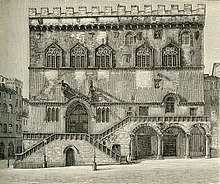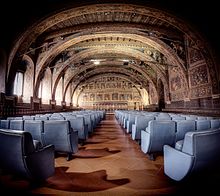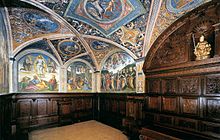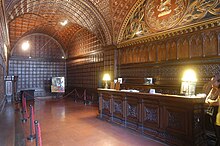Palazzo dei Priori
The Palazzo dei Priori or comunale is one of the best examples in Italy of public Palace of the età comunale (XI century). It is in the central in Perugia, Umbria. It extends along up to Via Boncambi. It’s still the seat of a part of the town hall and, on the third floor, it’s the seat of the Galleria Nazionale dell’Umbria.[1] It takes its name from the Priori, the highest political authority, who governed the city in the medieval era.
History and Architecture[]
The Palazzo was built in a gothic style between 1293 and 1443, in several phases. The irregularity of the facade is explained by the long construction procedure, due to constant additions and the incorporation of earlier buildings.
The most ancient part is the one that houses the Sala dei Notari, that is the corner part between and , It displays three triforas windows with a trefoil portal on the square's side and ten triforas and four-light windows facing the Corso.
It was the first building site, between 1293 and 1297, by the architects Jacopo di Servadio and Giovannello di Benvenuto,[2] both from Perugia.
At the beginning of the XII century, on the west side, that is the hidden side of the palace, the whole Palazzo Capitano del Popolo was incorporated, that earlier was the tower house of Madonna Dialdiana.
The subsequent extension was managed, between 1317 and 1326, by the architect Ambrogio Maitani from Siena who, with his brother Lorenzo, was hired to refurbish the aqueduct of Montepacciano, which carried the water to the square’s fountain. In this same period, lodgings were built for the new “Magistratura dei Priori” (created in 1303, made up by ten representatives of each one of the main guilds of the craft, between the 44 that existed, they had a tenure of only two months, in which they were housed in the palace). The lodgings consisted of the dormitory and the boardrooms on the first floor, the kitchen and the dining hall on the second floor and the Main Hall on the third. Those locations were used starting from 1325,[3] the same period in which the Portale Maggiore was built, that became the main entrance of the palace.
Between 1326 and 1331 the city purchased from Benvenuto di Cola dei Servitori a tower house, it was connected to the palace through an overpass, over Via dei Priori. On the old tower was built a bell tower. In 1331, in this area, was created the ancient Cappella dei Priori, consecrated to , brother of Roberto d’Angiò, of the d’Angiò’s lineage allied of the city; for this reason, the Lily emblem appears on the lunette of the portal and on the flank of the palace, along Via dei Priori crossing Via della Gabbia.[3]
In 1335, the facade was further extended, breaking the initial symmetry with the portico and the San Severo hall on the ground floor and of the other halls on the upper floors. In the extension, the church of San Severo di Piazza, of which only one wall remains inside, was incorporated to the palace (the appellation of S. Severo’s church was added to the nearby church of Sant’Agata, in Via dei Priori, which still has the double appellation)
Between 1429 and 1443 the palace was again enlarged, incorporating the church of San Giovanni al foro or di piazza, now chapel of San Giovanni, part of Collegio del Cambio, i.e., the guild of the money changers, part of the palace since 1452. For stylistic homogeneity it has been built in gothic style, even if in the XV century it was no longer used.[3]
From 1534 the palace housed the legato apostolico (an emissary of the Pope) and there were changes in the most recent wing of the palace. The architect Galeazzo Alessi, in the 80s of the XVI century, designed the internal and external arcade. Later the architect and sculptor Vincenzo Danti completed the work, with the enlargement of the internal staircase.
In the following years of Pontifical domain, the palace underwent a period of decline and was strongly changed both inside and outside (the crenellation disappeared, new windows were opened and the tiforas disappeared). It was restored according to the ancient look and refurbished after 1860.[2]
Description[]


External Facades[]
The facade fronting the square has a fan-shaped stairway built in 1902, to replace the one with two flights (dating back to the XVII century). It’s supposed in fact that the original one was fan-shaped.[3] The trefoil gothic portal is flanked by two tifore, same as the five above, which have a pinnacle on top. The two on the right were added with the subsequent extension. On the ground floor, there are three asymmetric arches; among them, a pulpit used for the reading of the edicts. Two big shelves above the gothic portal support the copy, in bronze, of the statue of the griffin, symbol of the city and the statue of the Guelph lion; the originals (now in the entrance hall of the palace) were created in 1274,[4] probably for a vanished fountain by Arnolfo di Cambio. The chains, which hang from the statue and the iron bar, are the same removed by the soldiers of Perugia from the door of Torrita di Siena, during the in 1358.[2]
The swollen facade, toward the Corso allows a glimpse of several extensions that have taken place over time. The walls on the first floor are decorated, as well as the facade on the square, by trifore and by two examples of four-light windows, while at the upper floor 19 wonderful trifore with a pinnacle, which combine the colour of the white and pink stones. The Guelph cornice and crenellation surround the extremity of both sides. On the ground floor, the shops substitute the “fondachi” (warehouses) and the artisan workshops. On the right of the portal here still the entrance of , occupying part of the palace from 1390, while the Collegio del Cambio is there from 1452.
Portale Maggiore[]
The Portale Maggiore or Portale delle arti, the dominant element of the building, attributed to local workers, was built in 1346. Rich in sculptural decoration, it is flanked by square pillars that lie on two lions, the one on the left with the allegory of magnanimity, fertility and haughtiness, and the one on the right with the allegory of stinginess, abundance and humility. On top of the pillars, there are two griffins, dominating two calves, symbol of Corporazione dei Macellai (guild of butchers), that paid for it. In the frame of the portal and the arch, there are bas-reliefs representing “Scene della Vita cittadina” (scene of city life). In the lunette, copies of the statue of the saints Lorenzo, Ercolano, Costanzo (or ), patron saints of the city.[5] The style and the size of the portal are in contrast with the palace; for this reason, it’s supposed that originally it was projected for an ecclesiastical building, but later instead it was used for Palazzo dei Priori. On the left side, in the frame of the portal, a figure with a title block, with the writing: “Entra Puro, move securo”(Come thither, be safe).[3]

The pulpit
The facade toward Corso Vannucci
The Portale maggiore

A Griffin and a Lion, symbols of the city, decorate the entrance from Piazza della fontana
The inside[]
The inside contains several locations of remarkable interest.

Sala dei Notari[]
The Sala dei Notari is located on the north side of the building. Originally it housed the assemblee popolari del libero comune (The people's conferences of the free Municipality) and it was also the offices of the courthouse of the Capitano del popolo. From 1582 it has been the office of the mighty guild of the Notari, from which it takes its name.
Wide location with vaults supported by eight arches decorated with frescoes dating back to the last decades of XIII century,[4] attributed to and to ,[6] both connected to the frescoes of the church of San Francesco di Assisi, they represent Aesop's fables; legends, biblical stories and maxims. In 1860 the frescoes have been heavily restored by the artist Matteo Tassi from Perugia, who added neo-gothic and eclectic decorations all over the surface, and repainted the emblems of the various podestà and capitani del popolo who succeeded in the government of the city. Two emblems of the magistrates in charge between 1293 and 1297, frescoed on the counter-facade of the hall, confirm the dating of the construction of the building.[3] Along the perimeter the seats line up, recreated in the XIX century on the original XVI century models. At the top, on the right wall there was a passage, connecting to the residence of Capitano del Popolo.
Sala dei Notari
The 16th century seats along the perimeter of the room
Detail
The medieval frescoes were realized by local artists
Sala della Vaccara[]
Located in the north side of the building, it is accessible through the stairs on the right of the portal of Sala dei Notari or from inside at the first floor. The room occupies the area of the ancient church of San Severo. The small entrance door has the shutters covered with an iron slab with carved griffin and in the centre two letters, A.G., which means “Armadium Generale”, i.e. the first municipal archive. In the upper part, an inscription of 1339 reports: MCCCXXXVIIII Gilius Rufinelli me fecit ( MCCCXXXVIIII Gilius Rufinelli made me). Before that date, the Dominican friars were those who took care of archive the municipal documents. Inside a gothic structure with a cross vault with ribs. On the vault on the left frescoes representing San Cristoforo, the protector of commercial traffic, and , who protects the various crafts working with cutting tools. On the back wall a fresco representing a nativity and saints, made by Tiberio d’Assisi (Umbrian school of XV century) coming from a little rural church. In 2010 a piece of the mannerist Antonio Maria Abbatini from Perugia (1598-1680) was positioned characterized by a large amount of figures in a very little space.
Sala del Consiglio[]
On the first floor the Sala del Consiglio comunale (Municipal Council), which door top exhibits a lunette with a fresco by Pinturicchio, representing the Virgin Mary between two Angels. In this room it is preserved the original Pietra della giustizia (stone of justice) of 1234, which was publicly shown in the main square (Piazza Iv Novembre). In its place, under the Logge di braccio, next to the cathedral, now a copy can still be seen.
Cappella dei Priori[]
On the third floor, now seat of Galleria Nazionale dell’Umbria, the Cappella dei Priori (Priors’s chapel) frescoed between 1454 and 1480 by the “official” artist Benedetto Bonfigli, with the stories of the life of , saint of the Franciscan order belonging to D’Angiò lineage, allied of Perugia, and ,[6] defined “Defensor civitatis” (civic defender), therefore patron saint of the city, who protected Perugia from the siege of Totila in 549; the paintings are of extraordinary importance for the description of the urban landscape, a proof of the medieval city, carefully reproduced. The not yet scientific perspective highlights the fabulous and mythological appearance of the events.
from Ascoli created the backbench of the choirs between 1452 and 1466.[7] The potter Giacomo di Marino, called “il cavalla”, between 1455 and 1457, made the glazed majolica floor, decorated with gothic-floral motifs on a blue background, alternated with flying angels of renaissance style.
For this room the Decemviri, in other words the ten priors in charge of the city, commissioned to Pietro Perugino, the , an (193x165 cm) datable to 1495-1496. In 1797 the painting, like other hundreds paintings belonging to the church, was confiscated by Napoleon’s troop, by means of the , as the object of the . In 1815, it was regained by Antonio Canova, and it was located in the Pinacoteca Vaticana in Rome. The cymatium with the Cristo in pietà (87x90 cm) luckily remained in Perugia and now is in the Galleria Nazionale dell’Umbria.
Sala del Collegio del Cambio[]

Another important room with an independent entrance on Corso Vannucci, is the room of Udienza del Collegio del Cambio, frescoed between 1498 and 1500 by Perugino, with the help of the pupil Raffaello (by him are the Fortezza and the face of Salomone) and furnished with a great wood bench (Domenico del tasso, 1492-1493) and seats along the walls (Antonio da Mercatello, 1508). The decoration is completed by a terracotta statue, which it is uncertain the realization (maybe of Benedetto da Maiano), representing justice.
The ceiling of was defined, by Edith Wharton in her "The Decoration of Houses", as one of the three perfect ceilings of the world: «Of all forms of ceiling adornment painting is the most beautiful. Italy, which contains the three perfect ceilings of the world - those of Mantegna in the Ducal palace of Mantua (see Plate XXV), of Perugino in the Sala del Cambio at Perugia and of Araldi in the Convent of St. Paul at Parma - is the best field for the study of this branch of art.[8]»

Sala del Collegio della Mercanzia[]
The Collegio della mercanzia, located in the second warehouse on the right of the Portale Maggiore, is entirely covered with a late gothic wood decoration.[9]
Notes[]
- ^ Umbria, p. 118
- ^ Jump up to: a b c Official site of tourism of Perugia
- ^ Jump up to: a b c d e f F.F. Mancini. Il Palazzo dei Priori di Perugia. Quattroemme.
- ^ Jump up to: a b "Umbria", Guida TCI, 1996, pag. 55.
- ^ Umbria, p. 119
- ^ Jump up to: a b Sito Culturaitalia.it
- ^ "Stalli del coro". Retrieved 12 May 2019.
- ^ Wharton, Edith (1897). The Decoration of Houses. B.T. Batsford. p. 97.
- ^ Umbria, pp. 120-121
Bibliography[]
- Touring Club Italiano-La Biblioteca di Repubblica (2004). L'Italia: Umbria. Touring editore.
- F.F.Mancini , Il Palazzo dei Priori di Perugia, ediz. Quatroemme"
Releted Items[]
External links[]
- Buildings and structures completed in 1297
- Buildings and structures completed in 1443
- Buildings and structures in Perugia
- Galleria Nazionale dell'Umbria
- Gothic architecture in Perugia
- Palaces in Umbria
- Tourist attractions in Umbria









